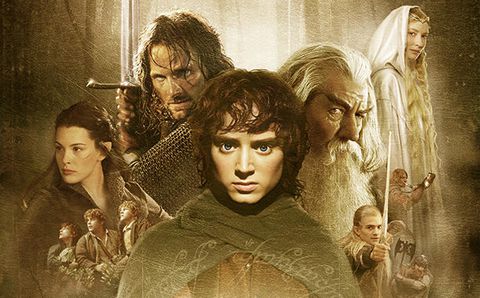After 3 days, 21 hours, 8 bags of popcorn, a dozen or more pee breaks, a walk in the park, and a short 8-hour nap (what, that’s a nap), I finally finished all 9 of the Hobbit/Lord of the Rings films, back to back, Extended Editions, in glorious HD.
And what do I get out of it, other than fulfilling my obsession with all things Tolkien? Well, I got to fulfill my obsession with all things Tolkien! AND a great idea for an article!
You see, after watching all 6 movies back to back to back to back, I’ve realized something: much like the Star Wars franchise, watching the Hobbit/Lord of the Rings in order according to its story flow would improve the viewing experience.
Of course, it’s not a novel idea: like I said, Star Wars fans are doing it, and even popular sites like Medium and Vice all gave their version of their preferred LOTR viewing orders. The viewing orders, created by hardcore fans like myself, were ordered in different ways other than chronology, which gave each order a unique experience for the viewers.
So here is my take on the LOTR Machete viewing order. I’ve compiled the list as a way to address certain problems I had with Jackson’s Hobbit series, speaking of which…
Peter Jackson’s Hobbit Films Were Pretty Bad
To say that the Hobbit series was problematic would be putting it lightly: there were a ton of issues that made the film almost unwatchable, not the least of which is a bloated storyline that tried its darndest to extend the 310-page source material over 3 films. I mean, I get it, you’re trying to make money for the studios, but at some point, it becomes less about telling Tolkien’s story and more just about making as much cash as possible.
My biggest problem, however, with the Hobbit trilogy is its use of spoilers and foreshadowing. Yes, the LOTR trilogy came out a decade before the Hobbit films, but I wish they had respected the order in which the books came out: Hobbit first, the Lord of the Rings second.
This is problematic for people who have never seen any of the LOTR movies (yes, they exist!): because it treated all of its viewers as life-long fans of the series, The Hobbit, if it wasn’t trying to overly stretch out its story, it sort of felt like fan service.
This, in itself, isn’t the most terrible thing, but it can alienate new fans to the franchise, not to mention confusing. What’s more the Hobbit trilogy, in its attempt to stretch out its source, had to include certain material that wasn’t in the original book, but rather, were referenced or written about in the Lord of the Rings books, various LOTR appendices, and the short story/essay collection Unfinished Tales of Númenor and Middle-earth.
And finally, my biggest peeve with the Hobbit trilogy is its last film, the Battle of the Five Armies, possibly one of the most contrived films in the entire Tolkien filmography. It’s not that it’s terrible, it’s just that it tries way too hard to top the Battle of Helms Deep and Pelennor Fields when the source material itself was only 20 pages. It was too over-the-top, too forced, too much, and in trying to top two of the most iconic battles in movie history, it did the exact opposite.
However, it wasn’t all bad.
Some of the added material, like the ones that gave a clear connection between the Necromancer and Sauron, to me gives the original trilogy a certain gravitas, a weight that might have been missed in first viewing of the LOTR series. The connection makes the quest for the Ring all the heavier and provides a little more context as to why the power players of Middle-Earth sprung into action at the Council of Elrond.
Extending the backstory, while bloating and at times over-explaining the entire Tolkien universe, does provide other LOTR characters context: Legolas, the Baggins family, and Middle-Earth in general. And the visuals! Praise Ilúvatar for the jaw-dropping visuals of the Hobbits series, which, to me, were a huge upgrade from the original trilogy, which was in itself was a stunning visual masterpiece.
Yes, there’s a lot to hate about the Hobbit films, but there’s a lot to love too, and including them in a Tolkien marathon is essential, provided, I think, that they’re watched in a certain order.
So here’s my take on a Machete-style Hobbit/LOTR Viewing order:
The Hobbit/Lord of The Rings Movies In Order
- The Lord of the Rings: The Fellowship of the Ring
- The Hobbit: An Unexpected Journey
- The Hobbit: The Desolation of Smaug
- The Hobbit: The Battle of the Five Armies
- The Lord of the Rings: The Two Towers
- The Lord of the Rings: The Return of the King
It may seem like a “whacked” chronology, but if you want to watch the Lord of the Rings in order, this is the way to watch.
A rundown of the main events from each of The Lord of the Rings and The Hobbit movies will help you see why this is the order you should follow.
The Lord Of The Rings: The Fellowship of the Ring
A powerful and ancient Ring that has been lost for centuries ends up in the hands of a small Hobbit named Frodo Baggins. When wizard Gandalf the Grey discovers that the Ring is the ONE Ring from the Dark Lord Sauron, he takes Frodo on a journey to the Cracks of Doom so they can destroy the evil ring. However, they do not journey alone.
They are joined by Legolas the elf, Aragorn, Boromir, Gimli the Dwarf and Frodo’s three Hobbit friends: Samwise, Gimli and Pippin. Together, they form the Fellowship of the Ring. Their mission is to destroy the One Ring to finally end the reign of Sauron.
The Hobbit: An Unexpected Journey
Long before Frodo Baggins began his journey, his uncle Bilbo embarked on an adventure of the ages. His story also begins with meeting Gandalf the Grey at his front gate. But at his time, Gandalf made an unusual offer: journeying to the massive fortress of Smaug, a greedy dragon who coveted gold. Together with Gandalf and twelve homeless dwarfs led by their former king Thorin, Bilbo and his crew journey to end Smaug, recover Erebor and the treasure.
This is where Bilbo also meets Gollum and finds a magical ring.
The Hobbit: The Desolation of Smaug
As Bilbo, Gandalf and Thorin’s long perilous journey to the Lonely Mountain continues, a pursuit by Azog, a vicious orc, leads the group into the dark forests of Mirkwood. Without the guidance and Gandalf, the dwarves and the hobbits continue their adventure into the unknown to retrieve the Arkenstone from Smaug.
On top of the pilfered gold, however, is a dangerous drake waiting silently to kill the coming party.
The Hobbit: The Battle of the Five Armies
As Smaug destroys Laketown, Thorin Oakenshield faces another threat — the gold madness that took his Grandsire Thror. In the middle of the chaos, the citizens of Laketown run to the ruins of Dale only to be greeted by the army of Elves. Demanding Thorin for their share of the gold, both elves and men are met with the dwarf’s defiance.
Thorin then faces the army of Lord Dain, his kinsman, In the meantime, Gandalf, imprisoned by the Necromancer, seems to meet his end but is rescued. The Necromancer turns out to be Sauron. While all of this is happening, Bilbo and his friends must protect Erebor from the Elves of Mirkwood.
The Lord of the Rings: The Two Towers
In the present time, the Fellowship has been torn apart. Frodo and Sam continue their journey to Mordor and come across Gollum, the same grotesque creature Bilbo meets in the previous The Hobbit films. Gollum (who also takes the mantle of Smeagol) is still consumed by the Ring and aims to steal it from Frodo. To do so, he pretends to guide them in their journey.
Meanwhile, Gandalf, Aragorn, Gimli and Legolas meet with new allies. Together, they defend the people of Rohan against Saruman, Sauron’s puppet. All the while, Sauron is preparing his attack on Gondor. Everyone is anticipating the War of the Ring.
The Lord of the Rings: The Return of the King
In the final showdown, Sauron’s forces have reached Gondor’s capital, Minas Tirith, to eliminate the race of men. But Aragorn, finally answering the call of his heritage, gathers the rest of Middle Earth to fight against the forces of evil.
At the same time, Frodo and Sam keep going to destroy the Ring at Mount Doom. But the closer Frodo gets to his destination, the heavier his burden becomes. His arrival at Mount Doom tests his allegiance and his humanity.
Making Sense of This Order of the Lord of the Rings and Hobbits Movies
This order is designed to address one of the major flaws of a chronological viewing order of the Hobbit and LOTR movies: if one were to watch the movies in order of their in-universe time, you’d watch Hobbit 1, 2, and 3, then LOTR 1, 2, and 3. However, because the Hobbit contains information/story elements that only make sense if the viewer has seen LOTR, the chronological order won’t work.
However, watching LOTR first before the Hobbit can take away the gravitas of certain scenes, like the Necromancer storyline and why it affects the major movers and shakers of Middle-earth, or even the source of Gollum’s madness as a result of his exposure to the Ring and why this effect took longer and was less pronounced on, say, Bilbo or Frodo.

Photo credits from: Weta Workshop
Another reason for this order: if one were to watch it in release order (i.e. LOTR, then Hobbit), you end your marathon with Battle of the Five Armies, arguably the weakest and most contrived film in the entire Tolkien franchise. Alternatively, with this order, you end with Return of the King, which serves not only as the end of LOTR, but of the entire Ring saga, of which the Hobbit is the start of. Return of the King is also a good way to end Bilbo’s story arc, highlight his redemption, and end his story in such a way that we see it from beginning, middle, and end.
In this order, the Fellowship of the Ring serves as a sort of prologue to the entire series, setting up key plot points in a more streamlined way, all the while retaining the Rings of Power as the central element of the entire franchise.
This is then followed up by the entire Hobbit trilogy. Here, we see Bilbo’s backstory, a larger context of Middle-earth, its socio-political and religio-mythological structures, and how/why certain characters/races react the way they did to certain events. For example, Saruman’s character is given more depth if we see his fall from benevolent wizard to evil conspirator. This order shows the context of his corruption as well as a bit of backstory.
The partners of the series are casinos for money https://iwashka.com.ua. If before you had to spend a lot of time and effort to choose a reliable gambling establishment, now there are ratings and reviews. Leading positions in such lists are taken by online casinos for money, where customers are not afraid to play in the paid mode, and even on a large scale. Also, it is impossible not to mention the extensive incentive system, which will make your stay on the site even more pleasant and profitable.
Next, this order also sets up the epic battle scenes in a more balanced way, starting with the Battle of the Five Armies, which, while the weakest of the three, is still an important plot point, not to mention a visual treat if you haven’t seen Helm’s Deep and Pelennor Fields. In this order, the battles are set up to increase in scale, magnitude, and importance.
With this order, we also see more of the Dwarves and their culture. The Fellowship of the Ring, and indeed the entire original LOTR trilogy, had a total of 5 seconds of Dwarves outside of Gimli which, while remaining true to the source material, was an omission that begged more questions about the Mines of Moria, the Balrog, among others.
Is It the Right Order
Obviously not! There is no right or wrong order; however, I believe that there are more enjoyable orders to watch the Lord of the Rings movies and a way to watch them that it gives it more weight, more magnitude, more epicness, and more enjoyability.
So, there. I hope you try bingeing on the Hobbit/Lord of the Rings in order! Let me know if it changed the way you see the Tolkien mythos, or if you have a viewing order of your own!




